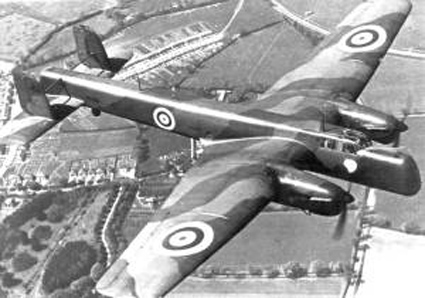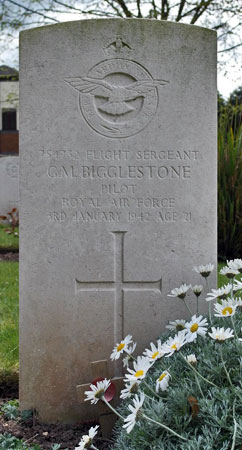On the night of 15th / 16th May 1941 the crew of this aircraft were one of a number of 10 Squadron crews tasked with bombing Hannover. They
took off from Leeming at 22.17hrs and this crew bombed the target area from 14,000 feet at 01.17hrs. The aircraft was attacked by an enemy aircraft
at around the same time but the crew fired a red signal flare and the enemy aircraft broke off its attack and searchlights in which the aircraft
was being held were switched off. The crew were able to make a safe return to base and landed safely at Leeming at 04.45hrs and a number of
bullet holes were found in the aircraft.
Pilot - Sgt George Milburn Bigglestone RAFVR (754732).
Second Pilot - Sgt Harris Black RAFVR (923087).
Observer - Sgt Hubert Richard Heighton RAFVR (745475).
Wireless Operator / Air Gunner - Sgt Robert Henry Thompson RAFVR (938712).
Wireless Operator / Air Gunner - Sgt C E Harrison RAF (755530).
F/Sgt George Bigglestone completed his Tour and was posted to 22 OTU. He died on 3rd January 1942 when Wellington X9640 crashed at Wellesbourne Mountford while flying a training flight. He was twenty one years old and is buried in Stratford on Avon Cemetery, Warwickshire. The photograph of his gravestone shown above was found on "militaryimages.net".

Sgts Black, Heighton and Thompson were flying in Whitley Z6816 on Ops to Osnabruck on 7th / 8th July 1941. The aircraft was thought to have crashed in the North Sea off Flamborough Head, Yorkshire. Their bodies were never found and they are commemorated on the Runnymede Memorial.
Sgt Thompson had earlier been flying in Whitley Z6721 on 12th / 13th June 1941 when the aircraft was ditched in the North Sea after suffering engine failure. The dinghy overturned but the five crew were able to climb into it with it upturned. After five hours in the raft the crew of a German Heinkel HeIII spotted them and flew towards an RAF ASR launch boat directing them towards the dinghy. As a result all five were rescued. For his efforts on this night another member of his then crew, Sgt Douglas Wilkinson, was awarded the British Empire Medal, Gazetted on 31st October 1941. The citation for his award adds alot of detail and reads.."One night in June 1941, this airman was the wireless operator of an aircraft which, in the course of an operation, was compelled to descend on to the sea off the Dutch coast. Although Sergeant Wilkinson had had trouble with his wireless set he had managed to maintain wireless contact with a home station until the aircraft crashed, thus enabling an accurate fix to be obtained of the aircraft's position. After the crash he released his captain who was strapped in and assisted him through the front top hatch. Sergeant Wilkinson was about to leave the aircraft, which by this time was half full of water, when he observed the navigator lying unconscious in the tunnel. Sergeant Wilkinson immediately went to the navigator's assistance, and dragging him into the cockpit, managed to revive him and then assisted him to climb out through the top hatch. Following him through the hatch, Sergeant Wilkinson saw the dinghy had not yet been launched so, dropping down on to the port wing, he jumped into the sea, swam round to the door and, opening it fully, enabled the rear gunner to throw out the dinghy. It failed to open but Sergeant Wilkinson pulled on the cord until it eventually opened but upside down. Eventually, however, the dinghy was righted and all the -crew were able to jump into it except the navigator who fell in the water. Sergeant Wilkinson grasped him and with the assistance of the rear gunner was able to pull the navigator into the dinghy. Within the next few minutes the aircraft sank. Sergeant Wilkinson showed great presence of mind and devotion to duty and undoubtedly was instrumental in saving the life of the navigator besides contributing largely to the successful launching of the dinghy which led to the eventual rescue of the entire crew."

Sgt Harrison saw out the War as a PoW. I have not yet located the aircraft in which he was flying.
Whitley Z6561 was built to contract 106962/40 by Armstrong Whitworth Ltd. at Baginton and was awaiting collection on 28th February 1941. During early March 1941 it was flown into MU storage at 45 MU at Kinloss but was quickly prepared for ops and ferried a few days later to Leeming where the aircraft became a spare aircraft. It was immediately taken on charge by 10 Squadron as a replacement for T4265 "ZA-J" lost on ops earlier in March 1941. As a result of the damage detailed above on 16th May 1941 Cat.A/FB would have been the assessment but there is no mention of this in the recorded history (probably as it was very slight). The aircraft would have been repaired on site and returned to the unit. On 28th June 1941 Cat.E m/FB damage was recorded when it failed to return from Ops to Bremen.